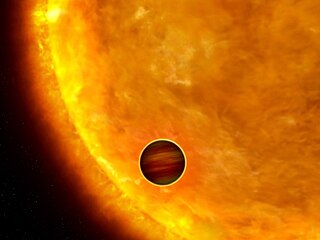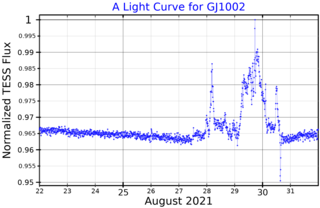Related Research Articles
Pi Mensae, also known as HD 39091, is a yellow dwarf star in the constellation of Mensa. This star has a high proper motion. The apparent magnitude is 5.67, which can be visible to the naked eye in exceptionally dark, clear skies. It is nearly 60 light-years away. The star is slightly larger than the Sun in terms of mass, size, luminosity, temperature and metallicity, and is about 730 million years younger. It hosts three known planets.
HD 4113 is a dual star system in the southern constellation of Sculptor. It is too faint to be viewed with the naked eye, having an apparent visual magnitude of 7.88. The distance to this star, as estimated by parallax measurements, is 137 light years. It is receding away from the Sun with a radial velocity of +5 km/s.
HD 190228 is a star with a substellar companion in the constellation Vulpecula. Its apparent magnitude is 7.30 – too faint to be seen with the naked eye – and the absolute magnitude is 3.34. Based on parallax measurements, it is located at a distance of 205 light-years from the Sun. The star is older than the Sun with an age over 5 billion years and it is metal-poor.
HD 213240 is a possible binary star system in the constellation Grus. It has an apparent visual magnitude of 6.81, which lies below the limit of visibility for normal human sight. The system is located at a distance of 133.5 light years from the Sun based on parallax. The primary has an absolute magnitude of 3.77.
HD 162020 is a star in the southern constellation of Scorpius with a likely red dwarf companion. It has an apparent visual magnitude of 9.10, which is too faint to be visible to the naked eye. The distance to this system is 102 light-years based on stellar parallax. It is drifting closer to the Sun with a radial velocity of −27 km/s, and is predicted to come to within ~18 light-years in 1.1 million years.

CoRoT-3b is a brown dwarf or massive extrasolar planet with a mass 21.66 times that of Jupiter. The object orbits an F-type star in the constellation of Aquila. The orbit is circular and takes 4.2568 days to complete. It was discovered by the French-led CoRoT mission which detected the dimming of the parent star's light as CoRoT-3b passes in front of it.
CoRoT-4 is a yellow-white dwarf main-sequence star in the constellation Monoceros.

CoRoT-1 is a yellow dwarf main sequence star similar to the Sun. The star is located approximately 2,630 light-years away in the constellation of Monoceros. The apparent magnitude of this star is 13.6, which means it is not visible to the naked eye; however, it can be seen through a medium-sized amateur telescope on a clear, dark night. The first exoplanet discovered in the course of the CoRoT mission orbits this star; it is considered to be a "hot Jupiter", and is approximately as massive as the planet Jupiter itself.
HD 139357 is a 6th magnitude K-type giant star located approximately 370 light years from Earth, visible in the constellation Draco. Its mass is four thirds that of the Sun but its radius is 11.47 times larger. However, despite being a giant star, it is only 3.07 billion years old, which is younger than the Sun.
CoRoT-2 is a yellow dwarf main sequence star a little cooler than the Sun. This star is located approximately 700 light-years away in the constellation of Aquila. The apparent magnitude of this star is 12, which means it is not visible to the naked eye but can be seen with a medium-sized amateur telescope on a clear dark night.
CoRoT-3 is a white-yellow dwarf main sequence star hotter than the Sun. This star is located approximately 2560 light-years away in the constellation of Aquila. The apparent magnitude of this star is 13, which means it is not visible to the naked eye but can be seen with a medium-sized amateur telescope on a clear dark night.
CoRoT-7 is a binary star system.
CoRoT-6 is a magnitude 13.9 star located in the Ophiuchus constellation.
HAT-P-13, also known as GSC 03416-00543, is a G-type main sequence star approximately 800 light-years away in the constellation Ursa Major. In 2009 it was discovered that this star is orbited by two massive planets, the innermost of which transits the star. This was the first known example of an extrasolar transiting planet with an additional planet in the same system.
HIP 70849 is a star with two non-stellar companions in the southern constellation Lupus. It is a 10th magnitude star, making it too faint to be visible to the naked eye. The system is located at a distance of 78.7 light-years from the Sun based on parallax measurements.
Kepler-39 is an F-type main sequence star located in the constellation Cygnus. It is located about 3,560 light-years away. One known substellar companion orbits it, Kepler-39b.
Gliese 880 is a small red dwarf star in the northern constellation of Pegasus that may host an exoplanetary companion. No stellar companions to Gliese 880 have been discovered as of 2020.
CoRoT-16 is a solitary star located in the equatorial constellation Scutum. With an apparent magnitude of 16, it requires a powerful telescope to be seen, and is located 2,400 light years away based on parallax.

GJ 1002 is a nearby red dwarf star, located 15.8 light-years away from the Solar System in the constellation of Cetus. The star has 12% the mass and 14% the radius of the Sun, and a temperature of 3,024 K. It hosts a system of two known exoplanets.
HD 72945 and HD 72946 form a co-moving star system in the northern constellation of Cancer. HD 72945 is a binary star that is dimly visible to the naked eye as a point of light with an apparent visual magnitude of 5.91. At an angular separation of 10.10″ is the fainter companion star HD 72946 at magnitude 7.25. It is being orbited by a brown dwarf. The system as a whole is located at a distance of approximately 84 light years from the Sun based on parallax measurements.
References
- ↑ "Finding the constellation which contains given sky coordinates". djm.cc. 2 August 2008.
- 1 2 3 4 5 Vallenari, A.; et al. (Gaia collaboration) (2023). "Gaia Data Release 3. Summary of the content and survey properties". Astronomy and Astrophysics. 674: A1. arXiv: 2208.00211 . Bibcode:2023A&A...674A...1G. doi:10.1051/0004-6361/202243940. S2CID 244398875. Gaia DR3 record for this source at VizieR.
- 1 2 "CoRoT-15". SIMBAD . Centre de données astronomiques de Strasbourg . Retrieved 26 October 2023.
- 1 2 3 4 Bouchy, F.; Deleuil, M.; et al. (January 2011). "Transiting exoplanets from the CoRoT space mission. XV. CoRoT-15b: a brown-dwarf transiting companion". Astronomy and Astrophysics . 525: A68. arXiv: 1010.0179 . Bibcode:2011A&A...525A..68B. doi:10.1051/0004-6361/201015276. S2CID 54794954.